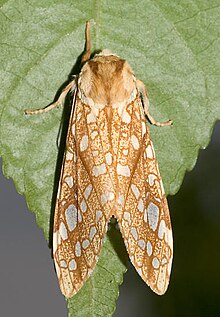Lophocampa caryae
| Lophocampa caryae | ||||||||||||
|---|---|---|---|---|---|---|---|---|---|---|---|---|

Lophocampa caryae |
||||||||||||
| Systematics | ||||||||||||
|
||||||||||||
| Scientific name | ||||||||||||
| Lophocampa caryae | ||||||||||||
| Harris , 1841 |
Lophocampa caryae is a butterfly ( moth ) from the subfamily of the bear moth (Arctiinae). The specific epithet refers to the hickory family ( Carya ), the main forage plants of the caterpillars. The species is known in English as the Hickory tussock moth .
features
butterfly
The moths have a wingspan of 37 to 55 millimeters. The upper side of the forewings has a yellow-brown basic color, which is covered with whitish spots. The upper side of the hind wing is not marked white. A head of brown hair stands out in the shape of a triangle on the head. The thinly haired thorax is bright yellow in color.
Caterpillar
The caterpillars are densely hairy whitish. There are short tufts of black hair on each back segment, with black point warts on the sides. Behind the head and at the end of the body, black or white tufts of hair consisting of a few very long hairs stand out on each side. The caterpillar hairs can lead to very itchy skin irritations and allergies in humans, which sometimes make medical treatment necessary.
Caterpillar in motion
Distribution and occurrence
The species is widespread in the east and southeast of North America from Nova Scotia in a southerly direction to north Florida , in Texas it occurs sporadically. It prefers to live in walnut groves and light deciduous forests.
Way of life
The diurnal moths fly in one generation in May and June. After fertilization, the females lay the eggs in large mirrors . Young caterpillars initially live gregariously, later individually. They feed on the leaves of different trees, including primarily hickory species ( Carya ) and other walnuts ( Juglandaceae ). Sometimes they have also been found on ash ( Fraxinus ), elm ( Ulmus ), maple ( Acer ) and oak ( Quercus ) species . As they develop, they absorb toxins from the leaves, making them inedible to potential predators. The species overwinters as a pupa in a cocoon between leaves.
Individual evidence
- ^ Butterflies and Moths of North America
- ↑ DA Kuspis, JE Rawlins, EP Krenzelok: Human exposures to stinging caterpillar: Lophocampa caryae exposures. In: The American journal of emergency medicine. Volume 19, Number 5, September 2001, pp. 396-398, doi : 10.1053 / ajem.2001.25772 , PMID 11555796 .
- ↑ dissemination
- ↑ Caterpillar behavior
Web links
- eol.org - Encyclopedia of Life


